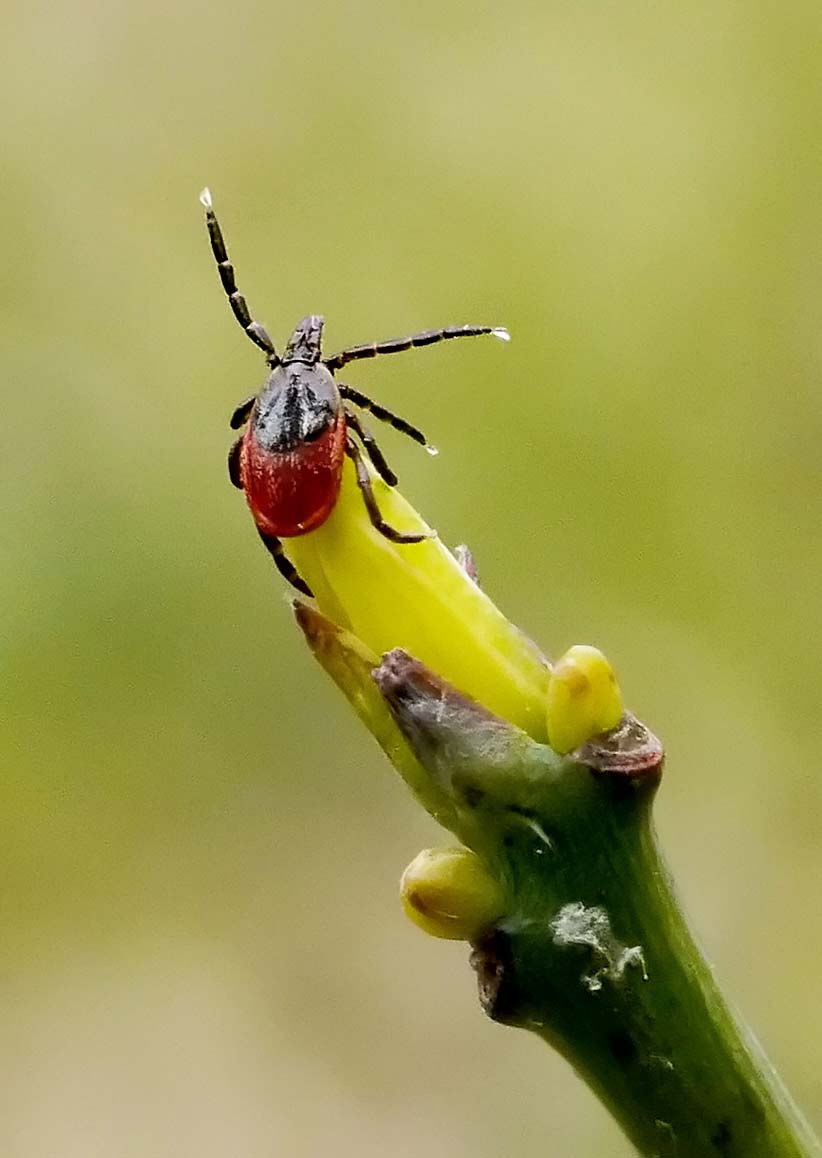News Release
For Immediate Release — October 20, 2011
Don’t Let Fall Bite You Back

Adult blacklegged ticks become active in fall – this ‘questing’ female has raised her front legs to sense suitable wildlife hosts as they pass by. (Image provided by Graham Hickling.)
Download photo
Hunters, hikers, fall foliage watchers should also be watching for ticks
KNOXVILLE, Tenn. — It’s autumn in Tennessee, and the state’s abundant natural resources are beckoning people to the woods—to hunt, hike or enjoy the beauty of fall foliage.
And that means potential exposure to blacklegged ticks, which could be carrying the bacteria that cause Lyme disease.
At the University of Tennessee Institute of Agriculture, ecological researchers are engaged in a four-year, National Science Foundation-funded study of ticks, and the risks they pose for transmitting several diseases. They are evaluating ticks at study sites in Tennessee, Alabama and North Carolina. While investigating disease risks, their work is also yielding practical tips regarding ticks and tick bites.
These tips include the following. Machine washing and drying of your clothes after being in the woods is a good idea, because tiny immature ticks can be almost impossible to spot. UT undergraduate John Norris found that ticks can survive the water and detergent in a washing machine, but are often killed by being pounded against jeans and other bulky clothes. Putting the wet clothes through the dryer is even more deadly and will quickly kill all the ticks.
If you discover a tick attached to your body, don’t trust the folk remedies of matches, lighters or petroleum jelly. Instead use tweezers. Grasp the tick as close to its mouthparts as you can and remove it by pulling straight out. Be sure to remove the mouthparts, if you didn’t get them on the first pull.
The scientists recommend that you place any tick that has bitten you in a small vial of alcohol and save it for a few weeks. That way if you develop symptoms of tickborne disease such as rash, fever, headache or muscle stiffness, the tick can later be examined to help determine which tick-borne disease you may have.
“The species of tick that has bitten you” says lead researcher Dr. Graham Hickling, “is a big clue as to which disease you may have contracted.”
Blacklegged ticks, the ticks that can carry Lyme disease, are in their adult stage in autumn. But there is good news on that front.
“We’ve found blacklegged ticks at each of our study sites, but always in very low numbers and almost never carrying the Lyme disease bacterium. In southeastern states, when someone is bitten by a tick it is usually a Lone Star tick or a Dog tick, and neither of those species spreads Lyme disease. In Tennessee, for example, when it comes to Lyme disease risk, we estimate roughly a one in a thousand chance of being bitten by the right tick species and almost zero percent chance of that tick being infected,” Hickling says.
People in the Southeast do get diagnosed with Lyme disease, but this may be a misdiagnosis or a result of visiting a northern state that has high numbers of ticks carrying the Lyme disease bacterium Borrellia burgdorferi. “Many people have heard of Lyme disease, but ticks spread other diseases too,” Hickling says. “Here in the Southeast people may be aware of Rocky Mountain spotted fever, but most have never heard of ehrlichiosis – even though it’s an emerging disease in this region.”
“Lyme disease is not the disease that’s at the top of my list to be concerned about in the Southeast,” Hickling says. “Rocky Mountain spotted fever is a problem because it can kill you fast, and Ehrlichia is the most common disease agent in southeastern ticks. So these are the two diseases that people here should be most alert for.” The team of graduates and students working with Hickling has found that 1 in every 20 lone star ticks carry Ehrlichia at a study site near Crossville, Tennessee.
The challenge for doctors is that different tick-transmitted diseases often start out with similar symptoms —fevers, headaches and muscle pains. “We want to reach doctors with the message that if their patient has made the effort to save the tick that bit them, then identifying that tick may help with diagnosis,” Hickling says.
UT’s tick research is being done in collaboration with scientists at five partner universities, each examining tick populations in their region The other universities include the lead institution, Michigan State University, and the University of Montreal, the University of Rhode Island, Hofstra University and Georgia Southern University. The project is funded for a further two years.
The Center for Wildlife Health is located within the Department of Forestry, Wildlife and Fisheries in the Institute of Agriculture at the University of Tennessee in Knoxville. The Center provides a multidisciplinary environment for the study of health issues arising from the interaction of wildlife, livestock, humans and the environment. The center contributes at both the regional and international level through seminars, academic courses, research and public outreach.
UT AgResearch is a division of the UT Institute of Agriculture, which provides instruction, research and public service through UT AgResearch, the UT College of Agricultural Sciences and Natural Resources, the UT College of Veterinary Medicine, and UT Extension offices in every county in the state.
###
Contact:
Dr. Graham Hickling, UT Center for Wildlife Health, ghicklin@tennessee.edu, 865-228-2474
Margot Emery or Patricia McDaniels, UTIA Marketing and Communications, 865-974-7141


